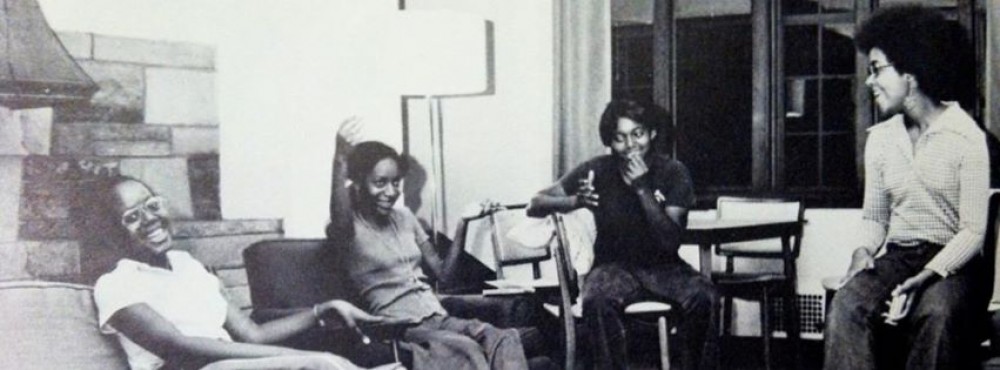This project was initiated by Emma Kioko, Bryn Mawr Class of 2015, in part inspired by UNC Chapel Hill’s “Black and Blue” College Tour designed by Dr. Tim McMillan, who provided us with the following resources to get started:
- “Black and Blue” tour website.
- Timothy J. McMillan, “Remembering Forgetting: A Monument to Erasure at the University of North Carolina,” in Silence, Screen, and Spectacle: Rethinking Social Memory in the Age of Information, eds. Freeman, Nienass, and Daniell (New York: Berghahn, 2014), 137-62.
- Richard Handler and Eric Gable, The New History in an Old Museum: Creating the Past at Colonial Williamsburg (Durham, NC: Duke University Press, 1997) [link to tripod]
The Black at Bryn Mawr blog cites a number of archival holdings located at Bryn Mawr Special Collections. Other sources of interest on the history of the College and its environs include:
- Helen Lefkowitz Horowitz, The Power and Passion of M. Carey Thomas (Knopf, 1994) and Alma Mater: Design and Experience in the Women’s Colleges from Their Nineteenth-Century Beginnings to the 1930s (Knopf, 1985; University of Massachusetts Press second edition, 1993)
- Perkins, Linda M. “The African American Female Elite: The Early History of African American Women in the Seven Sister Colleges, 1880-1960.” Harvard Educational Review 67.4 (1997): 718-756 [link to PDF] and “The Racial Integration of the Seven Sister Colleges” The Journal of Blacks in Higher Education 19 (Spring 1998): 104-108. [link to JSTOR]
- Barbara Alyce Farrow, The History of Bryn Mawr, 1683-1900 [link to Bryn Mawr College repository
- Harriton House/Harriton Cemetery [link to information collected by The Lower Merion Historical Society]
- Donna McDaniel and Vanessa Julye, Fit for Freedom, Not for Friendship: Quakers, African Americans, and the Myth of Racial Justice [link to web resources]
For further reading on the topics of race and higher education, we suggest the following:
- Martha Biondi, The Black Revolution on Campus (Berkeley: University of California Press, 2012) link to tripod
- Jacquelyn Dowd Hall, “The Long Civil Rights Movement and the Political Uses of the Past, Journal of American History 91.4 (March 2005): 1233-1263.
- Craig Wilder, Ebony and Ivy: Race, Slavery, and the Troubled History of America’s Universities (New York: Bloomsbury Press, 2013) link to tripod
- Corey D. B. Walker, “Fifty Years After Selma: Historically Black Colleges and Universities Create a Moral Vision of Education” (March 12, 2015) at Sightings, the blog of The Martin Marty Center for the Advanced Study of Religion
- Nigel Duara and Molly Hennessy-Fiske, “Furor over Oklahoma fraternity’s racist song may lead to lasting changes,” Chicago Tribune (March 14, 2015)
- Swarthmore College Black Liberation 1969 Archive
- Ibram H. Rogers, The Black Campus Movement: Black Students and the Racial Reconstitution of Higher Education, 1965-1972 (Palgrave Macmillan, 2012) link to Tripod
Colleges and universities, we argue, are sites of history and memory. We are inspired by other institutions of higher education in the U.S. pursuing projects that uncover invisible histories of slavery and colonialism:
- Slavery and Universities wiki (via Anne Donlon)
- “Clemson’s Past Hides in Plain Sight,” Greenville News report, March 2015
- Harvard and Slavery: Seeking a Forgotten History, by Sven Beckert, Katherine Stevens and the students of the Harvard and Slavery Research Seminar
- Princeton and Slavery project
- Robert Greene III, “A Process of Creating Public Memory: The University of South Carolina’s Two Desegregations” for USIH (April 2014)
- Remembering Race at Brown, Brown University Sophomore Seminar (2014-15) and Brown University Steering Committee on Slavery and Justice
- “Elihu Yale was a Slave Trader” by Joseph Yanielli for Digital Histories at Yale and “Open Letter Advocating for Diversity in Naming the New Yale Residential Colleges” [update: “Yale Grapples with Ties to Slavery in Debate Over a College’s Name,” in The New York TImes (September 2015)]
- UVA Names Building for Former Slave Couple, Starts Coming to Terms With its History (June 2015)
- “Folt calls for Full and Honest Rendering of Campus History,” The UNC-Chapel Hill University Gazette (September 2015)
We are also interested in conversations about collecting and interpreting student activism through college archives:
- Lae’l Hughes-Watkins, “Filling in the Gaps: Using Outreach Efforts to Acquire Documentation on the Black Campus Movement, 1965-1972,” Archival Issues(2014): 27-42. [PDF]
- Jarrett Drake, “Announcing ASAP: Archiving Student Activism at Princeton” (2015)
- Ellen D. Swain, “An Activist Approach to the Collection and Use of Student Documents in the University Archives,” Journal of Archival Organization 2 (2004): 39-53.
- Jessica L. Wagner and Debbi A. Smith, “Students as Donors to University Archives: A Study of Student Perceptions with Recommendations,” The American Archivist 75 (2012): 538-566.
In preparation for the March 2016 NCPH working group meeting, “Campus History as Public History,” we have collected similar articles and conversations under the hashtag #campushistories and made a Storify.
This list is a work-in-progress. Suggestions? Additions? Leave a comment below.
updated March 2016

I suggest you contact “The Equal Justice Initiatve” and their publications on Lynching in America- The Legacy of Terror; and Slavery in America; Bryan Stevenson’s “Just Mercy”; and Michelle Alexander’s “The New Jim Crow.”
These are terrific suggestions, thank you – every college student should be reading The New Jim Crow! –MM
Congratulations on a wonderful project. Inspired by the Brown Slavery and Justice Project, I have long been interested in claiming colleges and universities as historic sites of conscience, adapting the framework of the international consortium, Sites of Conscience. I’ll be using your resource and its links in my class here at the University of Michigan, “What College Means in America.” Thank you for your work.
Julie, thank you for your kind words! We are excited to learn about a number of classes and teachers introducing our project in their classroom, and I’d love to hear more.
— Monica Mercado